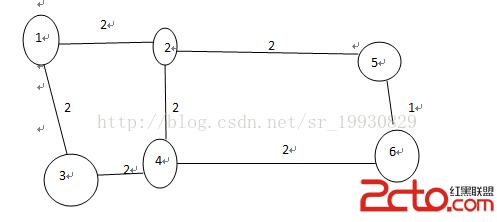2 3 2 1 2 1 2 3 1 3 3 1 2 1 2 3 1 1 3 1
Case 1: 1 Case 2: 2
本題為赤裸裸的最大流模板題。Ford-Fulkerson方法
其中為什麼要用到殘留網絡,不好理解。
下面講解有所啟發,轉載於:http://www.cnblogs.com/acSzz/archive/2012/09/13/2683820.html

必須使用反向弧的流網絡
在這幅圖中我們首先要增廣1->2->4->6,這時可以獲得一個容量為 2的流,但是如果不建立4->2反向弧的話,則無法進一步增廣,最終答案為2,顯然是不對的,然而如果建立了反向弧4->2,則第二次能進行 1->3->4->2->5->6的增廣,最大流為3.
Comzyh對反向弧的理解可以說是"偷梁換柱",請仔細閱讀: 在上面的例子中,我們可以看出,最終結果是1->2->5->6和1->2->4->6和 1->3->4->6.當增廣完1->2->4->6(代號A)後,在增廣 1->3->4->2->5->6(代號B),相當於將經過節點2的A流從中截流1(總共是2)走2->5>6,而不走2->4>6了,同時B流也從節點4截流出1(總共是1)走4->6而不是4->2->5->6,相當於AB流做加法.
代碼:#include#include #include #include #include using namespace std; using namespace std; const int maxn=20; const int inf=0x3f3f3f3f; int pre[maxn]; //保存前驅節點 bool vis[maxn]; int mp[maxn][maxn];//臨接矩陣保存殘留網絡 int s,e;//s為源點,e為匯點 int n,m;//輸入n個頂點,m條邊 bool bfs() { queue q; memset(pre,0,sizeof(pre)); memset(vis,0,sizeof(vis)); vis[s]=1; q.push(s); while(!q.empty()) { int first=q.front(); q.pop(); if(first==e) return true;//找到一條增廣路 for(int i=1;i<=n;i++) { if(!vis[i]&&mp[first][i]) { q.push(i); pre[i]=first; vis[i]=1; } } } return false; } int max_flow() { int ans=0; while(1) { if(!bfs())//找不到增廣路 return ans; int Min=inf; for(int i=e;i!=s;i=pre[i])//回溯找最小流量 Min=min(Min,mp[pre[i]][i]); for(int i=e;i!=s;i=pre[i]) { mp[pre[i]][i]-=Min; mp[i][pre[i]]+=Min; } ans+=Min; } } int main() { int t; scanf("%d",&t); int u,v,c; for(int cas=1;cas<=t;cas++) { scanf("%d%d",&n,&m); s=1,e=n; memset(mp,0,sizeof(mp)); while(m--) { scanf("%d%d%d",&u,&v,&c); mp[u][v]+=c; } printf("Case %d: %d\n",cas,max_flow()); } return 0; }